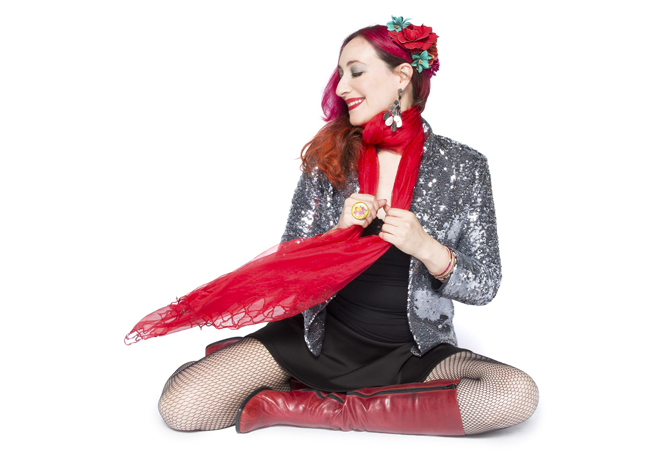
Photo Credit: Bill Bernstein
Video Feature & Web-Exclusive Interview
Musician: RACHAEL SAGE
Video: Joy! EP—Exclusive Stream
Hear The JOY! Rachael Sage Debuts First Holiday EP
Award-Winning NYC Songstress Rachael Sage Shares New Holiday Collection
Award-winning New York City songstress Rachael Sage never ceases to surprise. Whether it’s her innovative, often handmade stage-costumes or unlikely collaborations with artists like Howard Jones and Judy Collins, the colorful multi-instrumentalist is never afraid to give things her own spin. Joy!, her first EP of holiday-centric material, is no exception. The collection includes two original Hanukkah songs, a Yiddish ballad, and a cover of the timeless holiday classic “Joy To the World” with percolating acoustic guitar, chamber strings and an exuberant but intimate vocal delivery.
Rachael Sage is a soulful vocalist and innovative multi-instrumentalist who performs over 150 dates a year—throughout the US, UK, Europe and Asia. Her songs have appeared on MTV, HBO, Lifetime, Discovery and TLC—and in the remake of the movie Fame.
Joy! features members of her touring band, The Sequins, along with a variety of special guests including cellist Dave Eggar (Phillip Phillips) and violinist Rachel Golub (Adele, Bruce Springsteen). The new Holiday EP was produced by Sage and mixed by Grammy winner Andy Zulla and Grammy nominee John Shyloski.
We talked with Rachael about her songwriting, her creative drive, her fondness for the holiday spirit and the inspiration behind her new Holiday EP.
RACHAEL SAGE Web-Exclusive Interview
with M Music & Musicians magazine publisher, Merlin David
What inspired you to record this Holiday EP Joy!?
I’ve always loved Christmas music, and actually wrote a song when I was a little kid called “I Love You More Every Christmas,” which I intended to be a duet about a couple fighting on the holiday who realize they should resolve their conflict and just love each other better. Not surprisingly, as an assimilated Jew who listened to Top 40 from a tender age, I always had a fondness for the “holiday spirit” and the more secular aspect of Christmas—the pretty holiday lights, the gift-giving, and—the music.
How did you assimilate?
I went to a Christian school growing up and was one of only two Jewish students. So every year, my mom would field the inevitable question, “Is it OK if I sing a solo in the Christmas show?” just in case I was picked. She’d tell me yes, it was fine, and remind me that Irving Berlin composed the classic “White Christmas”—so it would be great if someday I could write a great holiday song too. I was also encouraged to write Hanukkah music, since all we really had was “Dreidel, Dreidel, Dreidel,” but it just didn’t happen—until now.
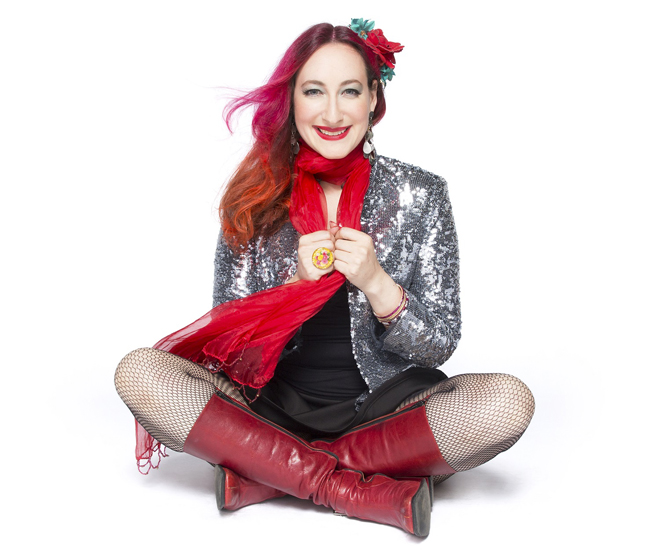
Photo Credit: Bill Bernstein
How did Joy! evolve?
A few years back, I started doing an annual holiday show at New York City’s Joe’s Pub. I titled the show “Tchatchkes & Latkes,” without any intention of writing a song with the same title. The night before the first show, it just kind of poured out. I hadn’t even memorized it yet, so I read it from a journal, and that was really the seed from which this project grew.
When did you write the other songs?
“Hanukkah in the Village” was written for my second reprise of the show. And last year I arranged “Joy to the World” for a holiday charity benefit my drummer invited me to play—with the strict direction that I could only play one original and one Christmas carol. I don’t do covers often, but once I’d recorded it, I felt like I had the makings of a collection and that it was a good balance of slightly unexpected and quirky holiday fare.
“Hanukkah in the Village” paints a beautifully detailed portrait of New York City.
This song was also part of the evolution of my annual show “Tchatchkes & Latkes” at Joe’s Pub. But the visual image that sparked the song was literally the holiday sale sign in the Patricia Field boutique on Bowery in NYC, which I could in fact see from my window—like the first line suggests.
Could you actually see it from your window?
Yes. One of my early gigs was working as a window dresser, and I always appreciate a great, creatively decorated window—which that store consistently delivered. It’s a very tongue in cheek song lyrically about all the not-exactly-spiritual things that comprise “holiday spirit” in NYC’s East Village—like clothing sales at boutiques, buying frozen latkes at Whole Foods, coming up with the right gift for a loved-one—concert tickets, musical boxed sets, pajamas. I wanted some of the absurdity of the holiday frenzy to come through in the lyrics but then I tried to juxtapose that with a very romantic, straightforward ballad arrangement. Live, most people seem to tap into the humor right away, but I’ve also noticed that some people listen to the recording and just think it’s a “pretty Hanukkah song.” I’m OK with that too.
Tell us about recording your first Yiddish song “Umru Meine”?
I’ve always wanted to learn to sing in Yiddish. About a year ago, I was presented with the opportunity to sing in a choir with The National Yiddish Theatre, supporting the brilliant Mandy Patinkin, in a Yiddish rendition of “Somewhere over the Rainbow”—at a benefit concert.
He seems to have an intensity that connects with everything he does.
It was so inspiring seeing him have such a visceral connection to our mother tongue, and I suppose it spurred me on. I, unfortunately, didn’t know my grandparents. I’ve never really had a way into learning Yiddish to speak, let alone sing. But soon after, the musical director of the theatre company, Zalmen Mlotek, offered to teach me the words and melody to the original “Umru Meine”—and he sent me an MP3 of him playing it himself.
Is this the original version?
I’ve never been very good at covering exactly what someone else does, so I set it to my own piano arrangement, composed a new bridge, and showed up to rehearsal a little “over-prepared.” Story of my life I suppose. (Laughs) I know I do this to compensate for my insecurity over not being able to read music, but sometimes it works in my favor and helps me really make a song my own. I had a debut performance last spring at a Mother’s Day benefit for The National Yiddish Theatre, and I am so grateful to be able to include it on this EP.
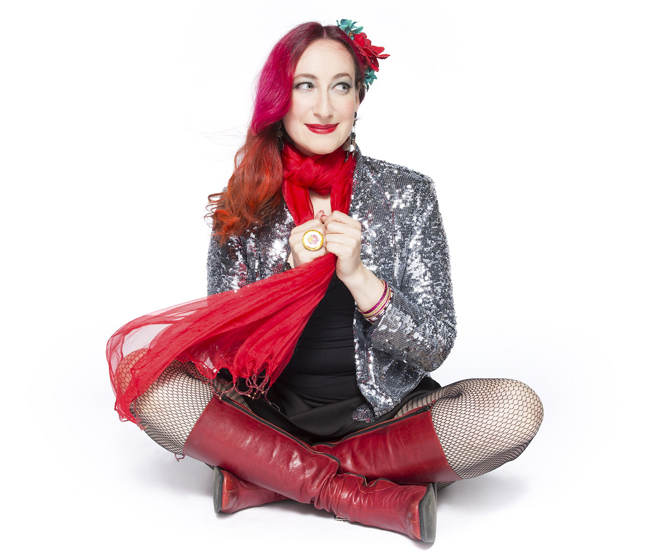
Photo Credit: Bill Bernstein
What did you learn about yourself during the recording of this Holiday album?
I learned that I probably have another full album’s worth of holiday material in me. (Laughs) And summer is a great time to start getting into the holiday spirit. I have absolutely no problem channeling the holidays in warm weather. Maybe this explains my annual urge to spend December and January in California.
Tell us about your writing process.
I used to write down every idea I ever had in little notebooks and have a constant record of my every creative reflection. For a long time this worked pretty well for me, and I’d go back to those ideas and spin them into songs, when I was lucky. But the older I get, the less I do that. I think it’s because I realized I was looking inward so often, I wasn’t living my life as much as I could— so as to actually have more, substantively, to share.
What songwriting tip would you like to offer?
I would encourage songwriter to be more adventurous in their “real life,” even if it’s just a day or two a week. And to remember that with the arts, you really are what you eat. Each one of us has so much to express but it’s easy to fall into the trap of expressing one or two things in a variety of different ways. People ask me now how I write songs—whether at the piano or the guitar or in my head walking down the street or recording in an iPad. It’s nice to be able to say yes, all of that—and also in the shower or banging on a djembe. Try to be flexible, and say yes to that invitation to go skydiving or even just to a museum, a movie or to a rally for something you believe in.
When did this shift happen for you?
I worked on my craft with an almost tunnel vision for many years, in my teens and 20s—at the expense of friendships, relationships and even my personal health. But now I’m catching up on widening my life-perspective, and I’ve never been more excited about songwriting, even if I don’t write quite as frequently.
Do you think it’s important for musicians to write songs that have greater social value—in hopes of eliciting change?
For me, it’s been vital. But it’s hard to speak for others. Earlier this year I wrote my EP The Tide very quickly and unexpectedly, and felt a need to share my handful of socially-conscious songs as soon as possible—and to do something positive by donating the proceeds to American Refugee Committee. The musicians I recruited were well aware of the nature of the project and we all connected in a very emotional way to the content—focusing on topics like intolerance and gun violence, but also on our inevitable humanity and vulnerability.
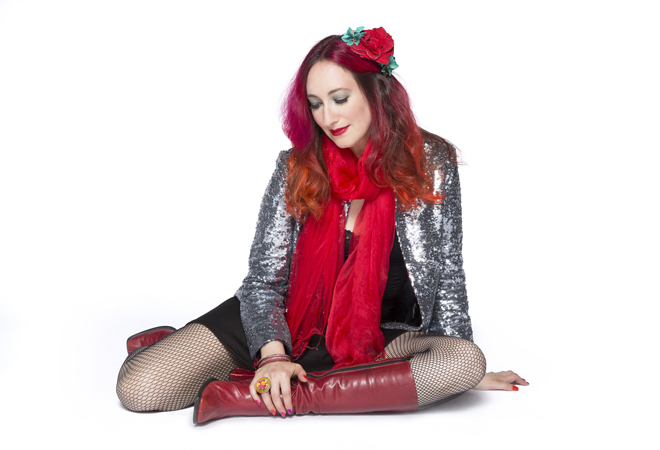
Photo Credit: Bill Bernstein
Was there a lesson learned?
In general, art reflects society, and so it becomes important to give voice to the voiceless—but also to entertain and provide hope and escapism, when necessary. I look at it as a balance—just like no one person can walk through life only focusing on the horrors we see on the news, without also giving or receiving some love, some uplift in their life. With so much violence and instability, it’s a pretty easy time for a lot of people to go crazy, literally and figuratively—which is why art is ever more important as an emotional safety-valve.
What song of yours addresses some of these socio-political issues that haunt our society?
All of the songs on The Tide address these issues in one way or another, but my favorite is the EP closer, “Tomorrow.” I cowrote it with my guitarist James Mastro (Ian Hunter, Garland Jeffreys) right after the Presidential election, and we were basically shell-shocked and commiserating with each other at dinner in London. The dinner chat turned into a challenge for us to go back to my hotel room and write a song reflecting how we both felt, but with some kind of hopeful spin on how having a divisive, reality star-president might eventually unify more people to come together “tomorrow,” in the broadest sense. There is always hope, in the aftermath of shock—because that’s when many people finally wake up to their beliefs and act upon them—and when people comfort one another and find their individual voices, in times of duress.
You play a Casio Privia, a Guild acoustic guitar and a Martin acoustic guitar. Are there any other instruments/equipment you use?
I play a lot of different instruments in the studio, but yes, my Casio Privia and Guild acoustic are my longtime live road axes, and I love them so much because they sound great and travel so well. In the studio, I always play a Steinway grand piano—a through-line on all 12 albums, and a Wurlitzer electric piano that John Lee Hooker introduced me to when I met him in college and used to go over to his house and jam on it. I’d never heard of, let alone played, one—until I met him—and now it’s my main composing instrument. I also record with a beautiful 1966 Martin acoustic, as well as two Gretsch electric guitars that have made recent appearances in my music videos. I recently acquired a gorgeous orange Gretsch semi-hollow electric guitar from the legendary guitar shop Matt Umanov, which is sadly closing after 50 years. It happens to be on my block, and I’ll miss that place so much. It was really an institution.
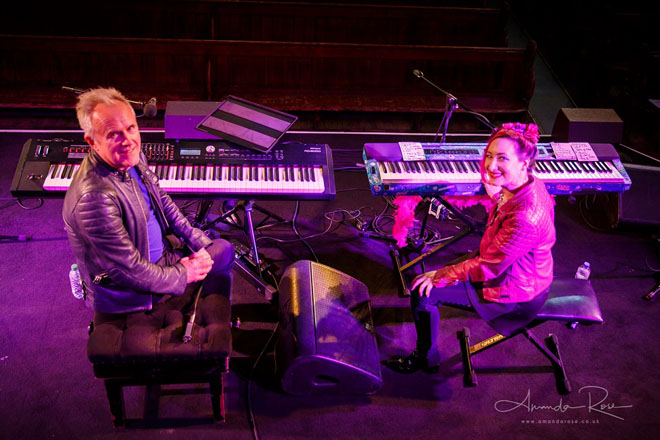
Rachael Sage, supporting Howard Jones, Union Chapel, London, 28th March 2017
Wait, you hung out with John Lee Hooker?
We met when I was a college DJ at Stanford. His organ player’s day job was delivering kegs to my dorm for happy hour, and I played piano at every happy hour. He sat down next to me, complimented my playing and asked if I wanted to come over the next weekend and meet Johnny Lee. I mentioned I was also a DJ and asked if I could interview JLH. He said he was sure JLH would love that. That’s how we first met. We became very good friends my junior year. I visited him frequently, had dinners, brought friends, watched videos and listened to music together. I even accompanied him to the Bay Area Music Awards, where he asked me who “that young fellow was,” when Elvis Costello was doing a tribute to him. (Laughs) It was an amazing experience getting to know him, and a lot of our relationship is reflected in my song “Blue Light,” a few albums back [2008’s Chandelier].
Sad about Matt Umanov Guitars closing.
Very sad about this but you can read all about it on their Facebook Page. I was in a couple weeks ago—everything was being sold at a heavy discount and the mood is definitely somber. What I’ve gathered from a friend who works there is simply that Matt did it for 50 years, looked around at the landscape and basically decided, “I don’t have to do this anymore.” So many guitarists and singer-songwriters relished that place. I bought my first acoustic guitar, the 1966 Martin, there many years ago—even before I could really play.
Is there anything special you do to take care of your voice?
I warm up before every gig and every vocal recording session. That’s a no-brainer, but I’m always amazed how many of my peers seem to think they don’t need to. I also warm down after gigs, especially if I have to do a lot of chatting after—with folks at the merch table. Talking actually wears on my voice much more than singing, so that becomes very important on tour. And I eat well—avoid dairy, chocolate, alcohol, etc. But more importantly, I just try to be as healthy as possible—eating plenty of greens, carrots, plant-based protein (hummus, nuts, avocado), and drink tons of water.
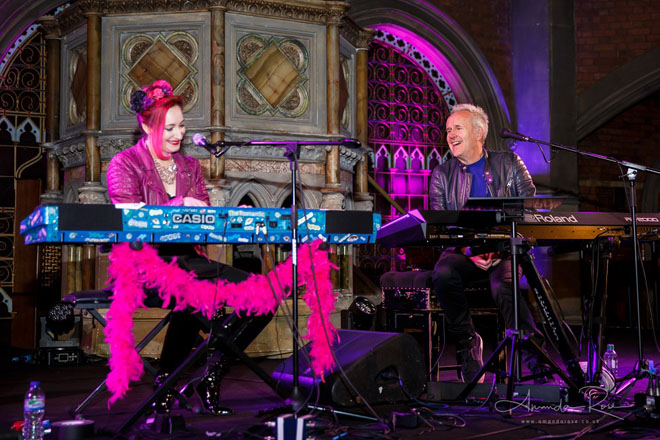
Rachael Sage, supporting Howard Jones, Union Chapel, London, 28th March 2017
Top 5 Musicians who inspired you to become a Musician?
Billy Joel, Carole King, Buddy Holly, Loretta Lynn, Elvis Presley.
Top 5 favorite albums of all time?
Sorry, I have to list seven—I can’t choose:
Piano Man (1973) – Billy Joel
The Unforgettable Fire (1984) – U2
I Do Not Want What I Haven’t Got (1990) – Sinéad O’Connor
Marc Cohn (1991) – Marc Cohn
Maria McKee (1989) – Maria McKee
99.9F° (1992) – Suzanne Vega
Rhythm and Repose (2012) – Glen Hansard
How was your recent tour with Howard Jones—someone you’ve admired for a long time?
When we were in London, we performed at a gorgeous venue called Union Chapel, which is a beautiful church that just sounds otherworldly. The sound mixes itself because the reverb is so gorgeous. After soundcheck, a photographer wanted to shoot Howard and me sitting side by side at our keyboards, which was already amazing. But then we sort of fell into jamming on “No One is to Blame”—which is something I don’t think I’ll ever forget. He’s such a lovely, down-to-earth person, and has a way of immediately putting you at ease—which is the mark of a true mensch, in my book.
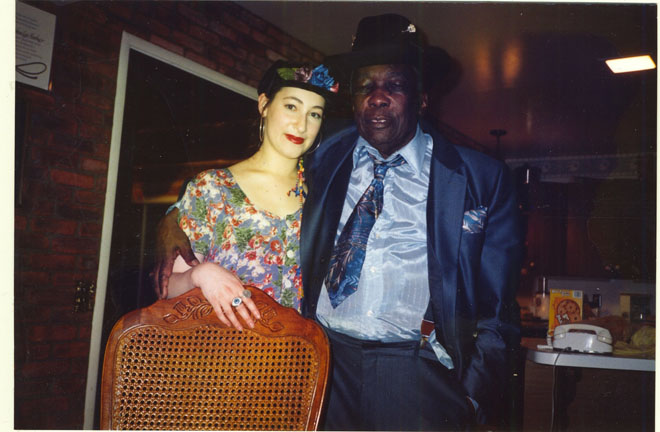
Rachael Sage with John Lee Hooker
Tell us another “pinch me” moment, where you found yourself saying, “Wow, this is really happening to me!”
The biggest “pinch me” moment I’ve ever had was in the studio recording “Helpless” with Judy Collins, at Avatar Studios. I literally turned to my engineer, and said those words. And he did. (Laughs)
Do you remember the first time you heard one of your songs on the radio?
In 1998, I released “Sistersong,” which had been inspired by the brilliant Ani DiFranco. It was my attempt at gratitude for her incredible courage and boldness as a songwriter and performer who “walked the walk” and was living her life with so much integrity and honesty. I really looked up to her when I was in college, and in many ways her music helped lift me up during a very dark time, so I really felt indebted. One day when I was just sitting alone in my apartment, I heard “Sistersong” on WFUV—and I almost broke a wall doing cartwheels. It was a pretty amazing feeling. Later, I ran into the fabulous DJ and music director Rita Houston, who told me she really liked the song—so that added another level of excitement.
What’s next?
I’m smack in the middle of recording my next full album, Myopia, which is slated for a May 2018 release. This winter, I’m going to be doing some more shows in the U.S. with Howard Jones—so keep an eye out very soon for those details on my website.
Where can new fans to stay updated?
www.RachaelSage.com
www.Facebook.com/rachaelsagepage
www.Instagram.com/rachael_sage
www.Twitter.com/rachaelsage
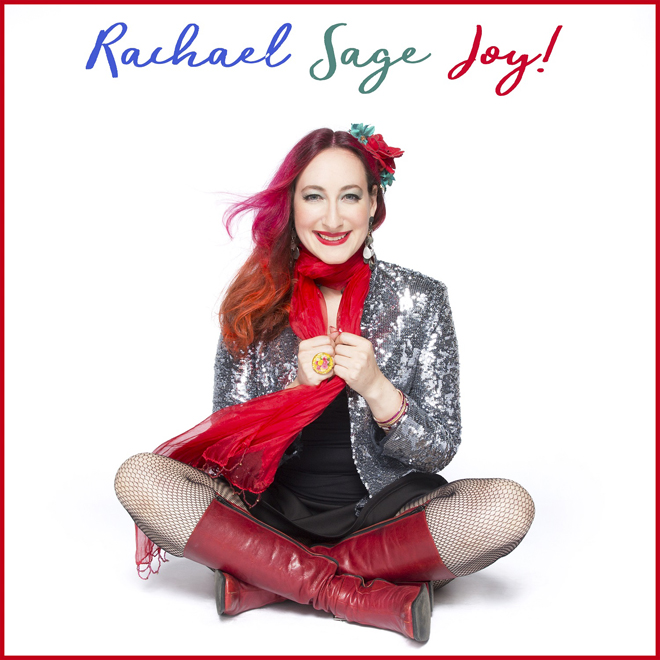



comment closed